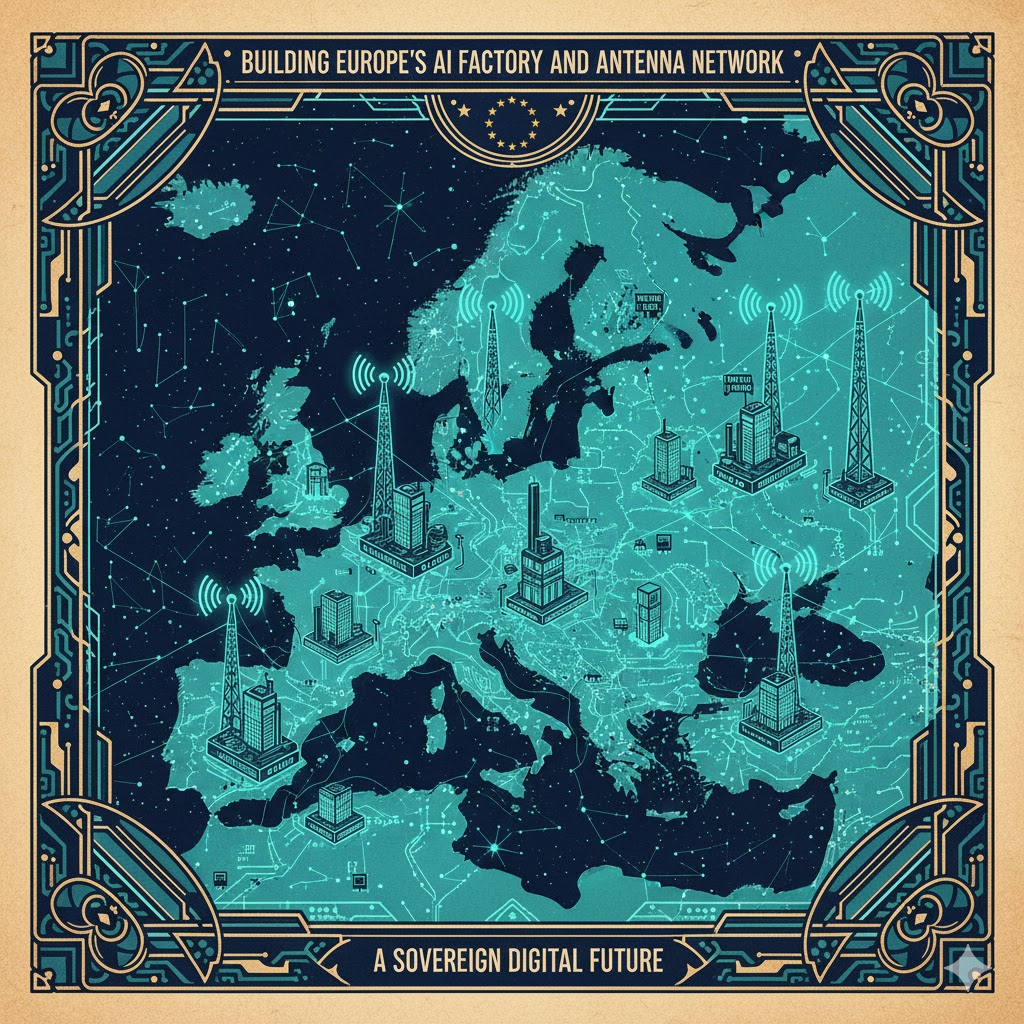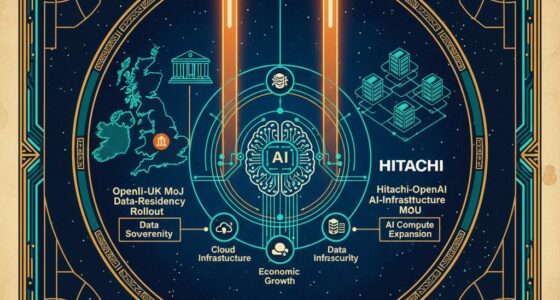Towards a Digitally‑Sovereign Artificial Intelligence Ecosystem
Executive Summary
The European Union is rolling out an ambitious AI Factory and Antenna network to close the compute gap that has hampered its artificial intelligence (AI) ecosystem and to reduce strategic dependence on non‑EU infrastructure.
By October 2025 the EuroHPC Joint Undertaking (EuroHPC JU) had selected 19 AI Factories and 13 AI Factory Antennas across Europe, supported by over €2.6 billion in combined investments from the EU and Member Statesdigital-strategy.ec.europa.eu.
These facilities, built around EuroHPC supercomputers, are designed as one‑stop shops that provide AI‑optimised high‑performance computing (HPC), data services, training and expert support for startups, small and medium‑sized enterprises (SMEs), researchers and public bodieseurohpc-ju.europa.eu.
The AI Factories will host powerful new or upgraded AI‑focused supercomputers – such as LUMI‑AI, HammerHAI, IT4LIA, Alice Recoque, JUPITER and 1HealthAI – while Antennas offer smaller systems and remote access to broaden the network’s reacheurohpc-ju.europa.eu.
By mid‑2026 these hubs are expected to operate in concert, enabling European companies and researchers to design, train and deploy advanced AI models within a digitally sovereign environment and underpinning the EU’s “AI Continent” ambitiondigital-strategy.ec.europa.eu.
1. Introduction and Policy Context
1.1 The compute gap and digital sovereignty
Europe accounts for about 4 % of the world’s AI computing power, compared with roughly 70 % for the United Statesseglerconsulting.com.
The aggregate EuroHPC fleet provides around 57 000 high‑end accelerators, whereas private US hyperscalers are deploying orders of magnitude more (for example Meta’s plan to use ~600 000 NVIDIA H100 GPUs)seglerconsulting.com.
This deficit, coupled with a €270 billion annual investment shortfallseglerconsulting.com, has created a strategic dependency on foreign compute that EU policymakers view as a geopolitical riskseglerconsulting.com.
To address this vulnerability the EU launched the AI Factories initiative in 2024 as part of its AI Continent Action Plan; the aim is to build public AI infrastructures as a complement to stringent regulations (the EU AI Act) and to ensure digital sovereigntyseglerconsulting.com.
1.2 From EuroHPC supercomputers to AI Factories
Since 2018 the EuroHPC JU has been procuring world‑class HPC systems.
By late 2025 it had commissioned 11 supercomputers, including JUPITER in Germany (Europe’s first exascale system), LUMI in Finland and Leonardo in Italyeurohpc-ju.europa.eu.
These machines not only rank among the world’s top 10 supercomputerseurohpc-ju.europa.eu but also serve as anchors for the AI Factories.
Rather than building entirely new infrastructures, the EU is repurposing and upgrading existing supercomputers to make them accessible to commercial AI usersseglerconsulting.com.
The AI Factories thus represent an extension of EuroHPC’s scientific mission into the commercial AI domain, offering compute, data and expertise to help companies develop and test AI models.
2. Development of the AI Factories Network
The AI Factories initiative follows a multi‑stage selection process.
2.1 First cut‑off (December 2024) – Seven pilot AI Factories
On 10 December 2024 the EuroHPC JU selected seven pilot AI Factories in Finland, Germany, Greece, Italy, Luxembourg, Spain and Swedeneurohpc-ju.europa.eu.
Five of these will deploy new AI‑optimised supercomputers, while Spain will upgrade the MareNostrum 5 system and Greece will operate an AI Factory around the DAEDALUS supercomputereurohpc-ju.europa.eu.
The selected factories will act as national one‑stop shops offering HPC, data services, training and support for AI innovatorseurohpc-ju.europa.eu.
This first wave comprises the following facilities:
| Country | Hosting entity / partners | System & focus sectors | Remarks |
|---|---|---|---|
| Finland – LUMI AI Factory | Hosted by CSC – IT Center for Science; consortium includes Finland and partners from Czechia, Denmark, Estonia, Norway and Polandeurohpc-ju.europa.eu | Utilises the LUMI‑AI system adjacent to the LUMI supercomputer; addresses data accessibility and cross‑border AI ecosystemeurohpc-ju.europa.eu | Provides an experimental platform for testing AI models and developing solutionseurohpc-ju.europa.eu |
| Germany – HammerHAI | Coordinated by the High‑Performance Computing Center Stuttgart (HLRS) with partners GWDG, LRZ, KIT and SICOSeurohpc-ju.europa.eu | Installs a new AI‑optimised system at HLRS for machine‑learning and hybrid HPC/AI applicationseurohpc-ju.europa.eu | Offers workflow templates, pre‑trained models and user education to lower AI adoption barrierseurohpc-ju.europa.eu |
| Greece – Pharos | Managed by GRNET and partners including Demokritos and Athena research centreseurohpc-ju.europa.eu | Builds on the DAEDALUS supercomputer in Athens; targets health, culture/language and sustainabilityeurohpc-ju.europa.eu | Provides end‑to‑end support complying with EU AI Act and sectoral regulationseurohpc-ju.europa.eu |
| Italy – IT4LIA | Led by CINECA Consorzio Interuniversitario; partners from Austria and Sloveniaeurohpc-ju.europa.eu | Upgrades the Leonardo supercomputer to an AI‑optimised system (up to 40× more powerful for AI workloads)eurohpc-ju.europa.eu | Targets agrifood, cybersecurity, earth and manufacturing sectors with data repositories and trainingeurohpc-ju.europa.eu |
| Luxembourg – MeluXina‑AI Factory | Coordinated by LuxProvide with partners Luxinnovation, LNDS, University of Luxembourg and LISTeurohpc-ju.europa.eu | Deploys MeluXina‑AI next to the existing MeluXina supercomputer to support finance, space, cybersecurity and green economyeurohpc-ju.europa.eu | Aims to offer rapid onboarding and personalised support for startups and SMEseurohpc-ju.europa.eu |
| Spain – BSC AI Factory | Led by Barcelona Supercomputing Center (BSC‑CNS) with partners from Portugal, Türkiye and Romaniaeurohpc-ju.europa.eu | Upgrades MareNostrum 5 to include AI computing and an experimental platform for testing new technologieseurohpc-ju.europa.eu | Focuses on public administration, health/pharma, finance/legal, agriculture/climate, energy and mediaeurohpc-ju.europa.eu |
| Sweden – MIMER | Hosted by National Academic Infrastructure of Supercomputing (NAISS) at Linköping University with RISEeurohpc-ju.europa.eu | Provides a mid‑range AI‑dedicated supercomputer emphasising cloud‑style access and storage for sensitive dataeurohpc-ju.europa.eu | Targets life sciences, material sciences, autonomous systems, gaming; includes generative models for drug design and personalised medicineeurohpc-ju.europa.eu |
2.2 Second cut‑off (March 2025) – Six additional AI Factories
On 12 March 2025 a second selection added six AI Factories in Austria, Bulgaria, France, Germany, Poland and Sloveniaeurohpc-ju.europa.eu.
This wave emphasises alignment with existing exascale systems (JUPITER in Germany and Alice Recoque in France) and extends the network to Eastern Europe.
| Country | Hosting entity / partners | System & focus sectors | Remarks |
|---|---|---|---|
| Austria – AI:AT | Led by Advanced Computing Austria (ACA) and AIT Austrian Institute of Technologyeurohpc-ju.europa.eu | Installs an AI‑optimised system at TU Wien; aims to support manufacturing industries with ethical and sustainable AIeurohpc-ju.europa.eu | Provides datasets, models and scalable infrastructure to enhance production planning and quality assuranceeurohpc-ju.europa.eu |
| Bulgaria – BRAIN++ | Hosted at Sofia Tech Park; features the Discoverer++ supercomputer and a comprehensive AI hubeurohpc-ju.europa.eu | Targets robotics, language models, space observation, manufacturing and trustworthy AI compliance toolseurohpc-ju.europa.eu | Provides a federated data lake, virtual AI sandboxes and entrepreneurship supporteurohpc-ju.europa.eu |
| France – AI2F | Led by GENCI with partners including CEA, CNRS, INRIA and France Universitéseurohpc-ju.europa.eu | Builds on the Alice Recoque exascale supercomputer; provides interim access via Jean Zay, Adastra and Joliot‑Curieeurohpc-ju.europa.eu | Serves sectors such as defence, energy, aerospace, agriculture, finance, humanities and healtheurohpc-ju.europa.eu |
| Germany – JAIF (JUPITER AI Factory) | Hosted by Jülich Supercomputing Centre with partners RWTH Aachen, Fraunhofer and otherseurohpc-ju.europa.eu | Utilises JUPITER, Europe’s first exascale supercomputer; includes an experimental inference module called JARVISeurohpc-ju.europa.eu | Supports healthcare, energy, climate, education, media, public sector, finance and insuranceeurohpc-ju.europa.eu |
| Poland – PIAST AI Factory | Led by Poznan Supercomputing and Networking Center with universities and regional clusterseurohpc-ju.europa.eu | Leverages PSNC’s HPC and EuroHPC quantum computer; focuses on health and life sciences, cybersecurity, space/robotics, energy/agriculture and public sectoreurohpc-ju.europa.eu | Aims to accelerate AI adoption through accessibility, sustainability and cross‑border cooperationeurohpc-ju.europa.eu |
| Slovenia – SLAIF | Coordinated by IZUM with Jožef Stefan Institute and ARNES; supported by five universitieseurohpc-ju.europa.eu | Deploys a new supercomputer near Mariborski otok; integrates with the VEGA petascale system and the SLING networkeurohpc-ju.europa.eu | Provides AI tools and services for companies and public sector, aligning national and European strategieseurohpc-ju.europa.eu |
2.3 Third cut‑off (October 2025) – Six more AI Factories
On 10 October 2025 EuroHPC JU announced six additional AI Factories in Czechia, Lithuania, the Netherlands, Poland (Gaia), Romania and Spain (1HealthAI)eurohpc-ju.europa.eu.
These selections bring the total to 19 AI Factories across 16 countriesdigital-strategy.ec.europa.eu.
They will be deployed in 2026 and will provide AI‑optimised compute, data and training resources similar to the earlier factorieseurohpc-ju.europa.eu.
| Country | Hosting entity / partners | System & focus sectors | Remarks |
|---|---|---|---|
| Czechia – CZAI | Led by VSB – Technical University of Ostrava with Brno University of Technology, Charles University and otherseurohpc-ju.europa.eu | Uses KarolAIna, an AI‑optimised upgrade of the Karolina supercomputer at IT4Innovationseurohpc-ju.europa.eu | Focuses on practical applications, technology infrastructure and skills development, serving industry, academia and public sectoreurohpc-ju.europa.eu |
| Lithuania – LitAI Factory | Led by Vilnius University with Kaunas University of Technology, Vilnius TECH, Vytautas Magnus University and partnerseurohpc-ju.europa.eu | Hosted at the LRTC VDC3 data centre; provides HPC, storage, accelerator access and innovation supporteurohpc-ju.europa.eu | Prioritises sectors such as cybersecurity, green energy, smart industry and digital healtheurohpc-ju.europa.eu |
| Netherlands – NLAIF | Led by AIFNL Foundation with SURF, Samenwerking Noord, TNO and AIC4NLeurohpc-ju.europa.eu | Deploys a new AI‑optimised supercomputer; offers customised AI compute on secure, scalable infrastructure that supports sensitive dataeurohpc-ju.europa.eu | Emphasises health, safety and agriculture applications and highly sensitive data (e.g., medical or IP‑protected information)eurohpc-ju.europa.eu |
| Poland – Gaia AI Factory | Operated by Cyfronet AGH within the PLGrid infrastructureeurohpc-ju.europa.eu | Expands infrastructure and access to big data repositories; provides training and advisory serviceseurohpc-ju.europa.eu | Targets entrepreneurs, students, public administration and sectors such as healthcare, space and large language modelseurohpc-ju.europa.eu |
| Romania – RO AI Factory | Coordinated by National Institute for Research & Development in Informatics (ICI Bucharest) with University Politehnica of Bucharest and otherseurohpc-ju.europa.eu | Plans to acquire an AI‑optimised supercomputer; offers HPC access, AI model development support, data hosting and algorithm librarieseurohpc-ju.europa.eu | Aims to transform SMEs from technology adopters into active AI innovators and to provide responsible/ethical AI toolseurohpc-ju.europa.eu |
| Spain – 1HealthAI (One‑Health AI Factory) | Hosted at the Galicia Supercomputing Center (CESGA) and supported by Spain’s Ministry of Science and Xunta de Galiciaeurohpc-ju.europa.eu | Develops a One‑Health‑focused AI supercomputer and an experimental platform; addresses human, animal and environmental healtheurohpc-ju.europa.eu | Partners include universities, the CIGUS network, the DATAlife digital innovation hub and Gradianteurohpc-ju.europa.eu |
3. AI Factory Antennas
To broaden access and build national ecosystems around the AI Factories, EuroHPC JU launched AI Factory Antennas.
These Antennas receive EU funding (~€55 million) matched by participating stateseurohpc-ju.europa.eu and provide smaller AI‑optimised systems, secure data environments and training.
They link national users to the high‑end compute of the AI Factories and can host local compute for fine‑tuning and testingeurohpc-ju.europa.eu.
The 13 Antennas selected on 13 October 2025 span multiple countries; each is associated with one or more AI Factories:
| Antenna & Country | Linked AI Factory/Farm | Focus sectors / services | Citation |
|---|---|---|---|
| BE‑AIFA – Belgium | Linked to LUMI AI Factory (Finland) and JUPITER AI Factory (Germany)eurohpc-ju.europa.eu | Supports defence/security, health, biotech, manufacturing, robotics, space/aeronautics and public sector; provides AI compute and data services for SMEs and talent developmenteurohpc-ju.europa.eu | eurohpc-ju.europa.eu |
| Pharos‑CY – Cyprus | Linked to Pharos AI Factory in Greeceeurohpc-ju.europa.eu | Accelerates trustworthy AI solutions in health, sustainability, culture and language; offers modular AI services and secure data environmentseurohpc-ju.europa.eu | eurohpc-ju.europa.eu |
| HunAIFA – Hungary | Linked to JUPITER AI Factory (JAIF)eurohpc-ju.europa.eu | Provides HPC‑accelerated AI infrastructure with sector‑specific support (healthcare, energy, agriculture, manufacturing) and access via HUN‑REN Cloudeurohpc-ju.europa.eu | eurohpc-ju.europa.eu |
| AIFA‑ICE – Iceland | Linked to LUMI AI Factoryeurohpc-ju.europa.eu | Offers national AI/HPC hub with a small test system; focuses on Icelandic language models and sectors like health and public administrationeurohpc-ju.europa.eu | eurohpc-ju.europa.eu |
| AIF IRL‑Antenna – Ireland | Linked to AI2F (France) and Luxembourg AI Factoryeurohpc-ju.europa.eu | Provides AI sandboxes, secure data environments and training; supports startups, SMEs and public bodies in adopting AIeurohpc-ju.europa.eu | eurohpc-ju.europa.eu |
| AIFA‑LAT – Latvia | Linked to LUMI AI Factoryeurohpc-ju.europa.eu | Builds modular, scalable infrastructure supporting research, experimentation and adoption across economy, academia and public administrationeurohpc-ju.europa.eu | eurohpc-ju.europa.eu |
| CALYPSO – Malta | Linked to Pharos AI Factory (Greece)eurohpc-ju.europa.eu | Functions as a national innovation hub with access to EuroHPC AI compute; targets finance, transport and health sectorseurohpc-ju.europa.eu | eurohpc-ju.europa.eu |
| FAIMA – Moldova | Linked to PIAST AI Factory (Poland)eurohpc-ju.europa.eu | Provides AI‑optimised computing and data services; focuses on agriculture/food, healthcare/life sciences and public sectoreurohpc-ju.europa.eu | eurohpc-ju.europa.eu |
| VEZILKA – North Macedonia | Linked to Pharos AI Factory (Greece)eurohpc-ju.europa.eu | Delivers AI solutions in health, energy, culture/language, agriculture and public administration while building a skilled workforceeurohpc-ju.europa.eu | eurohpc-ju.europa.eu |
| SAIFA – Serbia | Linked to Pharos AI Factory (Greece) and IT4LIA AI Factory (Italy)eurohpc-ju.europa.eu | Provides computing resources, AI tools, curated datasets and consulting; focuses on culture/language, sustainability, healthcare and agricultureeurohpc-ju.europa.eu | eurohpc-ju.europa.eu |
| SKAIAT – Slovakia | Linked to AI:AT (Austria)eurohpc-ju.europa.eu | Enhances cross‑border innovation; promotes industry–academia partnerships and trustworthy AI solutionseurohpc-ju.europa.eu | eurohpc-ju.europa.eu |
| HEARTS – Switzerland | Linked to LUMI AI Factory; collaborates with BSC AI Factory (Spain), MIMER (Sweden) and IT4LIA (Italy)eurohpc-ju.europa.eu | Provides AI compute and data services through the Alps infrastructure; showcases use cases in weather forecasting and sensitive‑data applicationseurohpc-ju.europa.eu | eurohpc-ju.europa.eu |
| UKAIFA – United Kingdom | Linked to HammerHAI (Germany)eurohpc-ju.europa.eu | Hosted at the Edinburgh Parallel Computing Centre; supports start‑ups, SMEs and industry across health, fintech, energy, engineering and roboticseurohpc-ju.europa.eu | eurohpc-ju.europa.eu |
4. Strategic Significance
4.1 Empowering startups, SMEs and researchers
Each AI Factory serves as a one‑stop shop providing AI‑optimised computing, storage and data services along with training and technical expertiseeurohpc-ju.europa.eu.
These resources lower barriers to entry for startups and SMEs, enabling them to test and train models without relying on non‑European cloud providerseurohpc-ju.europa.eu.
For example, the BSC AI Factory upgrades the MareNostrum 5 supercomputer and offers services for public administration, healthcare, finance and agricultureeurohpc-ju.europa.eu, while MIMER provides mid‑range compute with emphasis on sensitive data and generative models for personalised medicineeurohpc-ju.europa.eu.
The AI Factory Antennas extend these services to countries without large HPC facilities; they provide smaller AI systems and remote access, thus democratising AI compute across Europeeurohpc-ju.europa.eu.
4.2 Supporting digital sovereignty and compliance
By anchoring AI development on EU‑owned supercomputers, the network helps ensure that data and models remain under European jurisdiction.
It also aligns with the EU AI Act and sector‑specific regulations.
For instance, the Pharos AI Factory integrates compliance support for health, culture/language and sustainability projectseurohpc-ju.europa.eu, and IT4LIA provides robust frameworks to comply with security and privacy requirements while offering specialised services to SMEseurohpc-ju.europa.eu.
4.3 Building pan‑European collaboration
Many AI Factories involve consortia spanning multiple countries, encouraging cross‑border research and innovation.
The LUMI AI Factory includes partners from Finland, Czechia, Denmark, Estonia, Norway and Polandeurohpc-ju.europa.eu; the BSC AI Factory is a joint effort of Spain, Portugal, Türkiye and Romaniaeurohpc-ju.europa.eu.
Antennas such as BE‑AIFA and AIF IRL link national ecosystems to multiple AI Factorieseurohpc-ju.europa.eueurohpc-ju.europa.eu, fostering a cohesive network that can share datasets, software and expertise across Europe.
4.4 Integrating HPC and quantum computing
EuroHPC JU is not only deploying AI factories but also quantum computers; PIAST‑Q in Poland and VLQ in Czechia have already been inauguratedeurohpc-ju.europa.eu.
This integrated approach positions Europe to develop hybrid HPC/quantum AI workflows and to explore quantum‑accelerated machine learning, which could become critical for future AI performance.
5. Challenges and Critiques
While the AI Factories network is ambitious, analysts highlight several challenges:
- Scale and investment gap: Europe’s entire public infrastructure aggregates about 57 000 high‑end accelerators, far fewer than the hundreds of thousands of GPUs planned by individual US tech giantsseglerconsulting.com. Even with the AI Factory investments, Europe remains an order of magnitude behind in compute capacity.
- Administrative friction: Access to AI Factories is project‑based and peer‑reviewed, which may not align with the agile, on‑demand needs of commercial startupsseglerconsulting.com. Providing “free” compute without addressing later commercial scaling costs might leave companies unprepared for market realities.
- Regulatory paradox: The AI Factories act as a state subsidy designed to offset the compliance costs imposed by the EU AI Actseglerconsulting.com. Analysts argue that this policy dynamic may not tackle the underlying issues of Europe’s AI lag, such as limited venture capital, fragmented markets and talent retentionseglerconsulting.com.
- Sustainability and funding: Although more than €2.6 billion has been committeddigital-strategy.ec.europa.eu, the long‑term sustainability of the network depends on attracting private investment and on aligning procurement schedules across Member States. The “AI Gigafactory” concept – facilities with >100 000 processors – will require tens of billions in private capitalseglerconsulting.com.
6. Future Outlook and Recommendations
6.1 Timelines and next steps
The selected AI Factories and Antennas will finalise procurement and sign Memoranda of Understanding in 2025–2026eurohpc-ju.europa.eu.
By mid‑2026 all facilities are expected to enter service, supporting the development of generative models, large language models and other advanced AI applications across Europe.
EuroHPC JU continues to issue calls for additional AI Factories and Antennas, indicating that the network may grow beyond the current 19+13 sites.
6.2 Recommendations for stakeholders
- Simplify access and promote openness: EuroHPC should adopt more flexible access models (e.g., on‑demand credits) to accommodate startups’ rapid experimentation needs while maintaining peer‑reviewed access for academic projects.
- Strengthen talent and training: Each AI Factory should establish strong training programmes and collaborate with universities, digital innovation hubs and Antennas to develop AI curricula and upskilling opportunities, addressing Europe’s talent gap.
- Encourage public‑private partnerships: To bridge the investment gap, Member States and EU institutions should design incentives that attract private capital and cloud providers to contribute hardware, software and expertise to the AI Factory ecosystem.
- Focus on data availability and interoperability: Since data is essential for training AI models, the network should support the creation of secure, interoperable data spaces across sectors (health, manufacturing, energy) and encourage data sharing among Member States.
- Align regulation with innovation: Ongoing EU legislative efforts (AI Act, Data Act) should be harmonised with the AI Factories programme to ensure that compliance does not stifle innovation. The trustworthiness frameworks offered by Pharos, IT4LIA and other factories can serve as templates for responsible AI deployment.
- Monitor performance and impact: EuroHPC should publish transparent metrics on compute utilisation, projects supported, AI models developed, and economic impact to ensure accountability and to guide future investments.
7. Conclusion
The EuroHPC AI Factory and Antenna initiative represents a pivotal investment in Europe’s technological future.
By transforming existing supercomputers into AI‑ready hubs and connecting them through a network of Antennas, the EU seeks to create a digitally sovereign infrastructure that empowers startups, SMEs, researchers and public institutions.
The programme’s success will depend not only on deploying hardware but also on building vibrant ecosystems, simplifying access, mobilising private capital and aligning regulation with innovation.
If these challenges are addressed, Europe’s AI Factories could become a foundation for a competitive, trustworthy and inclusive AI landscape, helping the continent close the compute gap and maintain strategic autonomy in the global AI race.









